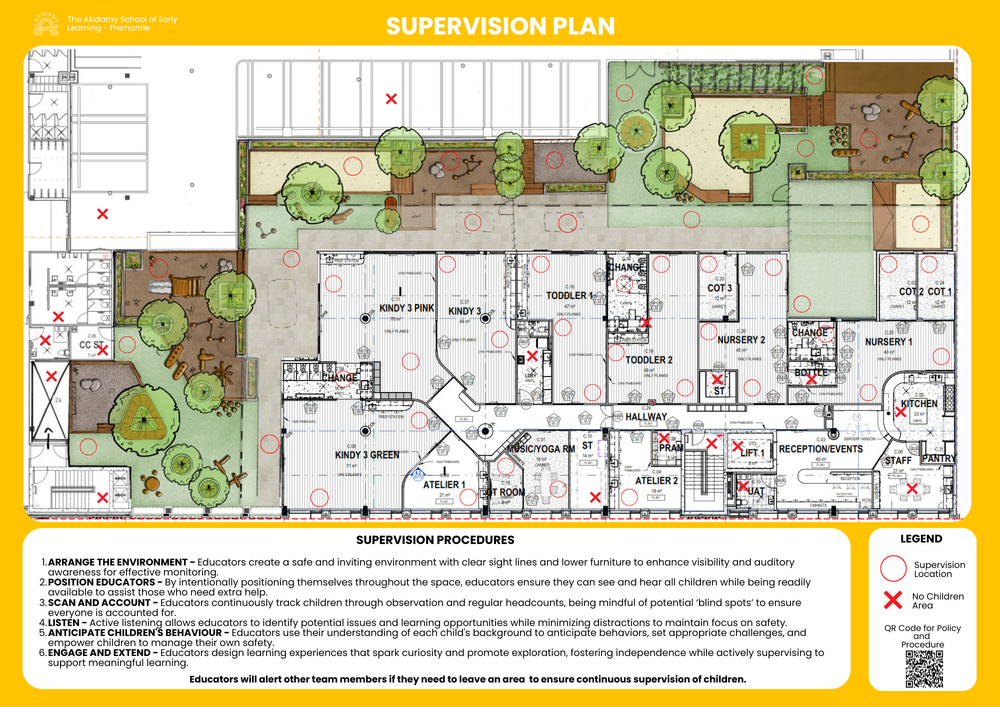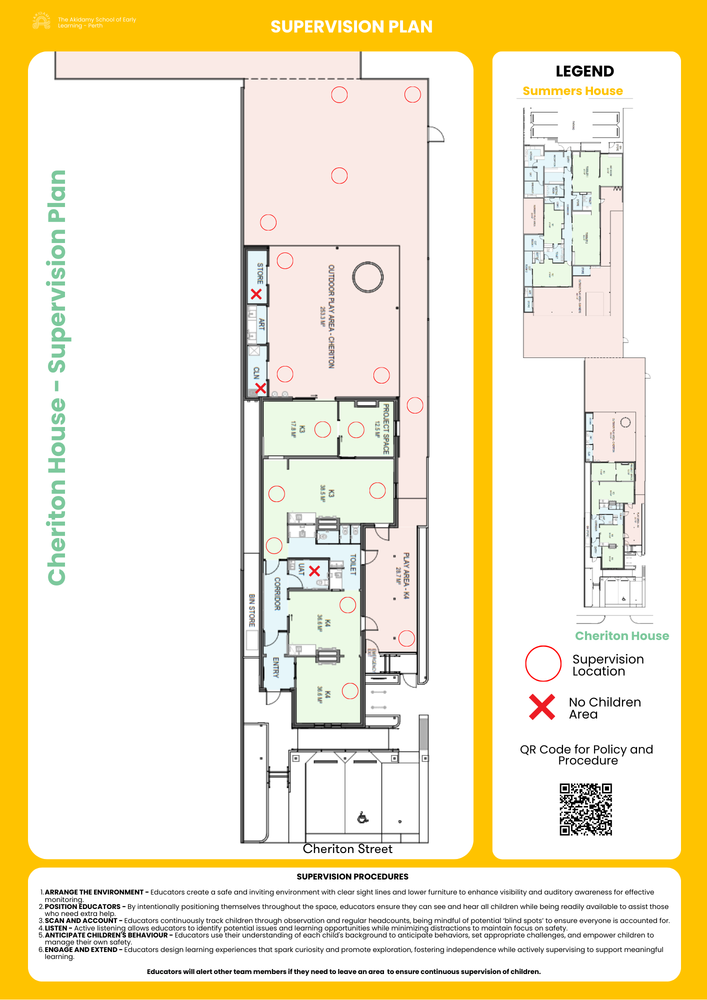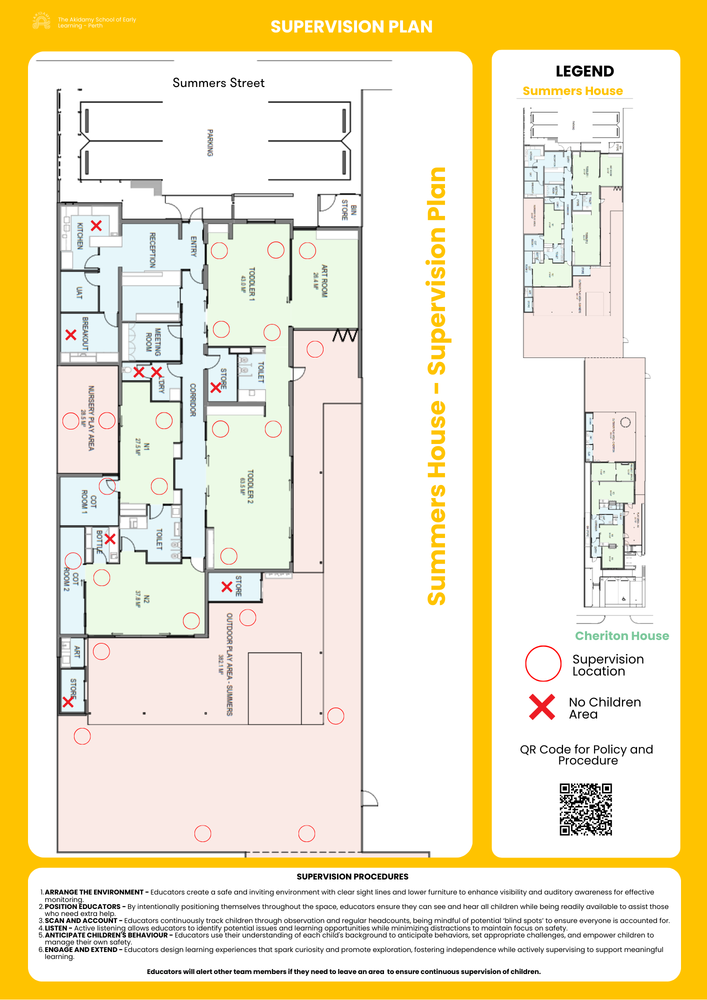Supervision Policy
Policy Content
Supervision is an integral part of the whole care and education experience.“At its most basic level, supervision helps to protect children from hazards or harm that may arise in their daily experiences in play, interactions with others, and daily routines.” (Victoria Department of Education and Training, 2010, p.1).
Effective supervision allows educators to actively engage in play and learning opportunities that are meaningful to children and support their wellbeing, development, and learning.
National Quality Standard (NQS)
| QUALITY AREA 2: Children's Health and Safety |
|---|
| 2.2 | Safety | Each child is protected. |
| 2.2.1 | Supervision | At all times, reasonable precautions and adequate supervision ensure children are protected from harm and hazard. |
| 2.2.2 | Incident and emergency management | Plans to effectively manage incidents and emergencies are developed in consultation with relevant authorities, practiced and implemented. |
Purpose
Educators have a duty of care to ensure children are supervised at all times, maintaining safe and secure environments whilst adhering to Education and Care Services National Law and National Regulations. Supervision, together with thoughtful design and arrangement of children’s environments, assists in the prevention and severity of injury to children.Educators will actively supervise children, identifying risks and taking all necessary steps to prevent or minimise injury. Effective supervision of children also provides educators with the opportunity to support and build on children’s play experiences.
Scope
This policy applies to educators, families, staff, management, Approved Provider, Nominated Supervisors, students, volunteers, and visitors to the School.Supervision Plans
Fremantle School
The following is the Supervision Plan for Fremantle School, located at Level 2, 28 Cantonment Street, Fremantle, WA 6160.
Perth School
The following is the Supervision Plan for Perth School, located at 105 Summerst Street, Perth, WA 6000.Note we have split this into buildings.
Summers House
Perth - Cheriton House

Implementation
Adequate supervision in a school requires careful consideration, depending on the different ages of the children and their varying abilities. Generally, the younger the child, the more they will need adults close by to support and provide assistance. Supervision of infants and toddlers who are sleeping needs careful consideration to ensure educators can see and hear children.Supervision of preschool age children may involve simultaneous use of indoor and outdoor environments and require effective supervision of children in both environments. (Source: ACECQA, 2020).
Nominated Supervisors will ensure:
- that the premises and facilities are designed and maintained to facilitate adequate supervision of children at all times while maintaining the rights and dignity of all children
- regulatory authorities are notified of any serious incident or complaint alleging the safety, health or wellbeing of children has been compromised within 24 hours of the incident or the time that the person becomes aware of the incident or complaint. This includes if an ambulance was called in response (not as a precaution) to an incident, situation or event.
- parents are notified as soon as practicable, but within 24 hours if their child is involved in a serious incident/situation at the School. Details of the incident/situation are to be recorded on the Incident, Injury, Trauma and Illness - record on EarlyWorks.
- educators under eighteen years of age may work at an Early Childhood School only if they are adequately supervised by an educator over the age of 18 at all times and are not left alone with children at any time
- minimum educator qualification requirements including how many educators are to be Early Childhood Teachers, are recognised and adhered to according to legislative requirements
- the School maintains the required educator-to-child ratio, working directly with children at all times, based on the ages and number of children being educated and cared for at the School.
- the school will have a register or roll for the week ahead – this is to prevent any technology defaults and make sure that we can always headcount the children. Paper rolls will be given to the studios at the start of each week this includes the phone numbers of parents again if there is a technology default this will help us to contact parents in case of emergency.
| Age Group | Educator To Child Ratios | Applies |
|---|
| For children from Birth to 24 months of age | 1:4 | All states and territories |
| For children aged 24 months and less than 36 months of age | 1:5 | All states and territories excluding VIC |
| For children aged 36 months of age or over | 1:10 | Western Australia |
For ratio requirements for some preschools and disadvantaged preschools in states/territories, see the Information Sheet provided by ACECQA - acecqa.gov.au/Improved-educator-to-child-ra...
Nominated Supervisors will:
- ensure that all educators are aware of where all children are at all times and monitor their environment closely
- ensure educators are able to respond to any situation immediately, particular when a child is distressed or in a hazardous situation
- ensure continuity of care and adequate supervision at all times when children are being cared for and educated in the School and on excursions
- ensure flexibility of supervision to provide for educators to supervise individual children or small groups of children
- ensure educators are aware that if they need to move away from children, another educator is to replace them. (e.g., collecting additional resources or attending to an individual child’s needs)
- conduct risk assessments and plan ongoing supervision taking into consideration the layout of the premises and grounds, any higher risk activities, the presence of any animals, the location of activities and the location of bathroom and nappy change facilities.
- develop, maintain and regularly review a supervision plan and strategies for both the indoor and outdoor areas, which will support educators to position themselves effectively to allow them to observe the maximum area possible
- ensure educators employ ‘active supervision’ strategies at all times
- ensure educators avoid activities or actions that will distract them from supervision, such as speaking to other educators for long periods of time,
- ensure educators are positioned to allow them to observe the maximum area possible
- ensure educators move around the environment to provide maximum vision of the area and avoid standing with their back to children or talking with other educators
- adopt accepted best practice; ensuring no staff member is left alone with a child to support child protection protocols
- ensure that a Risk Assessment and Management Plan is carried out before an authorisation is requested for an excursion. The risk assessment will consider and identify the number of adults required to ensure continuous adequate supervision throughout the excursion.
- monitor and maintain staff to child ratios to ensure adequate supervision of children
- have a sound understanding of their duty of care and responsibilities in ensuring children are within a child safe environment at all times
- communicate and collaborate with others to ensure the effective supervision of children within the School
- alert other colleagues if they need to leave an area for a particular reason to ensure continuous supervision of children (e.g., to obtain resources, visit the bathroom)
- adhere to a supervision tool and strategies for both the indoor and outdoor environment, assisting colleagues to position themselves in order to effectively supervise children’s play.
- implement vigilant supervision strategies for hygiene requirements including:
- regular handwashing
- toileting
- cough and sneeze routines - using disposable tissues and handwashing
- inform new and relief educators about supervision arrangements, outlining their supervision responsibilities
- ensure any educator under the age of 18 years old is never left alone with children
- ensure that at least one other educator is within sight when working with children and when supporting children with toileting/hygiene routines
- arrange the education and care environment to maximise the ability of educators to supervise all areas accessible to children. Emphasis will be on gates, the fence line and doors during arrival and departure times.
- communicate with each other about their location within the environment and any relevant information about supervising individual children to ensure their needs are met
- maintain correct ratios adhering to the Education and Care Services National Regulations throughout the education and care environment
- providing flexible rostering of supervision depending on the age of children and needs of individual children
- promote children’s agency by making decisions about supervision that allows children to engage in independent exploration and appropriate risk taking
- actively engage with children to support their learning whilst actively supervising and observing children
- ensure that all children are in sight or hearing of educators at all times
- ensure that no child is left alone while eating or at nappy change and toileting times
- adequately supervise children during rest time in accordance with the Sleep and Rest Policy and relevant legislative requirements
- adequate supervision is provided when children are transported in a vehicle at all times
- ensure that hazardous equipment and chemicals are inaccessible to children
- scan the environment during interactions with individuals or small groups
- implement correct supervision strategies and not perform other duties while responsible for the supervision of children
- listen closely to children whilst supervising areas that may not be in a direct line of sight noticing changes in volume or tone of voice.
- plan for a mixture of activities to allow for appropriate supervision of groups of children.
- using supervision skills to recognise areas of risk therefore reducing the potential for injury or incident to children and adults
- providing direct, constant and proximal monitoring to children undertaking activities that involve some risk and recognising when the ratio of educators to children needs to be increased (e.g., carpentry, water activities, climbing)
- guiding educators to make decisions about when children’s play needs to be interrupted and redirected
- supporting educators with specific strategies for supervision such as positioning, peripheral vision and monitoring children’s arrival and departure from the school
- providing consistent supervision strategies when the School requires relief educators.
Supervision Guidelines & Procedure
Effective supervision is integral to creating environments that are safe and responsive to children’s needs and interests. Identifying potential risks and hazards allows educators to determine the level of supervision required for different situations and environments while promoting children's agency, exploration, and development.Working in conjunction with the Supervision Policy, this procedure provides guidelines for educators to follow to ensure effective supervision while supporting children’s wellbeing, development and learning. See the attached Child Supervision Procedure.
| No. | Supervision Guidelines |
|---|---|
| 1 | Planned positioning Educators position themselves to be able to scan or regularly look around the area to observe children in the environment. Educators ensure close proximity to children who may require additional support. |
| 2 | Practicing awareness Requires knowledge of individual children – knowing each child’s range of skills, interests, ability to interact with others and developmental stage. Knowledge of children helps educators to monitor and enhance skills that promote children’s agency. |
| 3 | Being alert to the surrounding environment Involves educators regularly glancing around the outdoor and indoor area and listening carefully to volume and tone of children’s voices. Children who are not in an educator’s direct vision are still able to be supervised and responded to immediately if required. |
| 4 | Using redirection Children can be redirected to other areas or activities when they are unable to problem solve on their own or undesirable behaviour is imminent or likely to occur. This technique helps ensure the safety of all children. For this to be effective, educators need to be knowledgeable of the children in their care and any behaviour plans that are current. |
| 5 | Provide close supervision In areas that may pose a potential risk to children’s health and safety, educators are required to evaluate the situation and determine if intervention is required depending on the age and ability of each child. Sometimes, a child needs reassurance to explore and take appropriate risks with the support of an adult. Educators must be aware of ‘blind spots’ within different environments. |
| 6 | Consideration of all children Educators are aware of the different ages, personalities, behaviours and characteristics of the children in their care to ensure that different levels of supervision is relevant and responsive to each child’s developmental needs. |
| 7 | Consistent supervision strategies Support a positive, inclusive approach to children’s ability to make responsible and appropriate decisions about their behaviour, interactions with others and their learning. |
| 8 | Actively supervising hygiene practices Supervising and modelling appropriate practices such as hand washing, use of hand sanitiser, cough and sneeze etiquette assists in ensuring the health and safety of children and staff. |
| 9 | Observation and engagement Being responsive to children’s supervision needs and engaging in opportunities to promote independence and learning. |
| 10 | Communication and collaboration Ensuring all staff are aware of the needs of individual children and the supervision they may require in any given situation or environment. Communicating when changes in supervision occur due to a range of variations- collecting resources, visiting the bathroom, attending to an individual child’s needs. |
| 11 | Health and Safety Ensuring effective supervision of children due to illness or injury. Children must be closely supervised and kept safe, comfortable until their parents/guardian is able to collect them from the school. |
| 12 | Clear supervision plans Ensuring all educators (including relief staff) understand supervision guidelines and procedures to ensure the safety of all children. |
| 13 | Self-reflection Consider your own supervision practices (observation skills to anticipate times when children may need closer supervision). |
| No. | Active Supervision Strategies |
|---|---|
| 1 | Educators are to communicate and collaborate with others to ensure the effective supervision of children within the school. |
| 2 | Educators will avoid activities or actions that will distract them from supervision, such as speaking to other educators/ families for long periods of time, taking personal phone calls, checking mobile phones or administrative tasks. |
| 3 | Educators are to position themselves to allow them to observe the maximum area possible. |
| 4 | Educators are to move around the environment to provide maximum vision of the area and avoid standing with their back to children or talking with other educators. |
| 5 | Educators will alert other staff if they need to leave an area for a particular reason to ensure continuous supervision of children (eg: to obtain resources, visit the bathroom). Another educator is to replace them, ensuring ratios are maintained at all times. |
| 6 | Educators will actively engage with children to support their learning whilst actively supervising and observing children. |
| 7 | Educators will ensure that all children are in sight of educators at all times. |
| 8 | Educators will ensure that no child is left alone while eating or at nappy change and toileting times. |
| 9 | Educators are to adequately supervise children during rest time in accordance with the Sleep and Rest Policy and relevant legislative requirements. |
| 10 | Educators will scan the environment during interactions with individuals or small groups. |
| 11 | Educators will listen closely to children whilst supervising areas that may not be in a direct line of sight noticing changes in volume or tone of voice. |
| 12 | Educators will plan for a mixture of activities to allow for appropriate supervision of groups of children. |
| 13 | Educators complete regular headcounts throughout the day especially during transition times for children and staff members. |
| 14 | Educators make sure that children are not taken into areas not for children - eg shed, laundry, staff room, kitchen. |
| No. | Supervision Procedure |
|---|---|
| 1 | The Approved Provider, Nominated Supervisor and educators will review and update the School’s Supervision Policy each year. |
| 2 | Educators are to be aware of where all children are at all times and monitor their environment closely. |
| 3 | Educators are to be able to respond to any situation immediately, in particular when a child is distressed or in a hazardous situation. |
| 4 | The Director/ Nominated Supervisor will develop and maintain rosters that ensure continuity of care and adequate supervision at all times when children are being cared for and educated in the school and on excursions. |
| 5 | The Director/ Nominated Supervisor is to adopt accepted best practice; ensuring no staff member is left alone with a child (where possible) to support child protection protocols. |
| 6 | Educators will have a sound understanding of their duty of care and responsibilities in ensuring children are within a safe environment at all times |
| 7 | Educators will implement vigilant supervision strategies for hygiene requirements including:
|
| 8 | The Director/Nominated Supervisor will inform new and relief educators about supervision arrangements, outlining their supervision responsibilities. |
| Educators will ensure that hazardous equipment and chemicals are inaccessible to children. | |
| 10 | Educators will ensure adequate supervision is provided when children are transported in a vehicle at all times (see Safe Transportation Policy). |
Risk Assessment are located in 1Place
| No. | Supervision Plans And Risk Assessments |
|---|---|
| 1 | The Director/ Nominated Supervisor and educators will conduct risk assessments and plan ongoing supervision taking into consideration the layout of the premises and grounds, any higher risk activities, the presence of any animals, the location of activities and the location of bathroom and nappy change facilities. |
| 2 | The Director/ Nominated Supervisor and educators will ensure the supervision plan and strategies will be displayed for families in all rooms and in the outdoor area. |
| 3 | The Director/ Nominated Supervisor will ensure that a Risk Assessment and Management Plan is carried out before an authorisation is requested for an excursion. The risk assessment will consider and identify the number of adults required to ensure continuous adequate supervision throughout the excursion. |
| 4 | The Director/ Nominated Supervisor and educators will regularly evaluate the efficiency of the supervision plan and make changes as required. |
Source
Australian Children’s Education & Care Quality Authority. (2020). Active Supervision: Ensuring safety and promoting learning.Australian Children’s Education & Care Quality Authority. Children’s Health and Safety. An analysis of Quality Area 2 of the National Quality Standard. Occasional Paper 2. (2016).
Early Childhood Australia Code of Ethics. (2016).
Education and Care Services National Law Act 2010. (Amended 2018).
Education and Care Services National Regulations. (2011).
Frith, J., Kambouris, N., & O'Grady, O. (2003). Health & safety in children's centres: Model policies & practices (2nd ed).
Guide to the Education and Care Services National Law and the Education and Care Services National Regulations. (2017).
Guide to the National Quality Framework. (2017). (amended 2020).
Revised National Quality Standard. (2018).
Tansey, S. (2005). Supervision in children's services [Putting Children First, the Newsletter of the National Childcare Accreditation Council], Issue 15, p. 8-11.
Victoria Department of Education and Training. (2012). Supervision [Practice Note 12]: education.vic.gov.au/Documents/childhood/providers...
Did this answer your question?
If you still have a question, we’re here to help. Contact us

